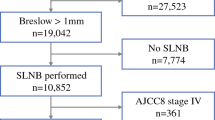Abstract
Background
The overall prognosis of patients with thick cutaneous melanoma (TCM) is generally thought to be poor. Surgically staging these patients with sentinel lymph node (SLN) biopsy remains controversial. This study was performed to determine whether SLN status improved our ability to predict outcome over other known prognostic factors and to develop a model incorporating independent prognostic factors to estimate the risk of recurrence for an individual patient.
Methods
A prospective database identified patients with TCM (>4.0 mm or Clark level V) and clinically negative nodes who underwent SLN biopsy. Univariate and multivariate analyses were performed.
Results
From 1991 to 2001, 126 patients were identified; 75 (60%) were male. The median age was 60 years. The median tumor thickness was 5.5 mm, and 43% were ulcerated. Thirty percent of patients had a positive SLN. Recurrence was seen in 50 patients (40%). Median follow-up, relapse-free survival, and overall survival were 25, 50, and 68 months, respectively. Factors independently predictive of recurrence were age ≥60 years, depth >5.5 mm, ulceration, and SLN positivity. SLN status was the most significant prognostic factor (P< .001). The relative risk of recurrence for an individual patient ranged from 1 in patients for whom no adverse factors were present to 29.4 when all factors were present.
Conclusions
SLN status was the strongest independent predictor of outcome in patients with TCM. However, patients with TCM are prognostically heterogeneous, and all independently predictive factors should be considered when an individual patient’s risk of recurrence is assessed.
Similar content being viewed by others
References
Balch CM. Surgical management of regional lymph nodes in cutaneous melanoma.J Am Acad Dermatol 1980;3:511–24.
Balch CM, Soong SJ, Milton G, et al. A comparison of prognostic factors and surgical results in 1,786 patients with localized (stage I) melanoma treated in Alabama, USA, and New South Wales, Australia.Ann Surg 1982;196:677–84.
Kim S, Garcia C, Rodriguez J, Coit D. Prognosis of thick cutaneous melanoma.J Am Coll Surg 1999;188:241–7.
Gershenwald JE, Mansfield PF, Lee JE, Ross MI. Role for lymphatic mapping and sentinel lymph node biopsy in patients with thick (≥4 mm) primary melanoma.Ann Surg Oncol 2000;7:160–5.
Balch CM, Soong SJ, Gershenwald JE, et al. Prognostic factors analysis of 17,600 melanoma patients: validation of the American Joint Committee on Cancer melanoma staging system.J Clin Oncol 2001;19:3622–34.
Beahrs OH, Meyers MH, eds.Manual for Staging of Cancer: American Joint Committee on Cancer. 2nd ed. Philadelphia: Lippincott, 1983.
Beahrs OH, Henson DE, Hutter RVP, Myers MH, eds.Manual for Staging of Cancer: American Joint Committee on Cancer. 3rd ed. Philadelphia: Lippincott, 1988.
Beahrs OH, Henson DE, Hutter RVP, Kennedy BJ, eds.Manual for Staging of Cancer: American Joint Committee on Cancer. 4th ed. Philadelphia: Lippincott, 1992.
Fleming ID, Cooper JS, Henson DE, et al., eds.Manual for Staging of Cancer: American Joint Committee on Cancer. 5th ed. Philadelphia: Lippincott-Raven, 1997.
Balch CM, Buzaid AC, Soong SJ, et al. Final version of the American Joint Committee on Cancer staging system for cutaneous melanoma.J Clin Oncol 2001;19:3635–48.
Coit DG. How we do it: the Memorial Sloan-Kettering Cancer Center approach. In: Cody HS III, ed.Sentinel Lymph Node Biopsy. London: Martin Dunitz, 2002:135–42.
Coit D, Sauven P, Brennan M. Prognosis of thick cutaneous melanoma of the trunk and extremity.Arch Surg 1990;125: 322–6.
Sylaidis P, Gordon D, Rigby H, Kenealy J. Follow-up requirements for thick cutaneous melanoma.Br J Plast Surg 1997;50: 349–53.
Author information
Authors and Affiliations
Corresponding author
Rights and permissions
About this article
Cite this article
Ferrone, C.R., Panageas, K.S., Busam, K. et al. Multivariate prognostic model for patients with thick cutaneous melanoma: Importance of sentinel lymph node status. Annals of Surgical Oncology 9, 637–645 (2002). https://doi.org/10.1007/BF02574479
Received:
Accepted:
Issue Date:
DOI: https://doi.org/10.1007/BF02574479




